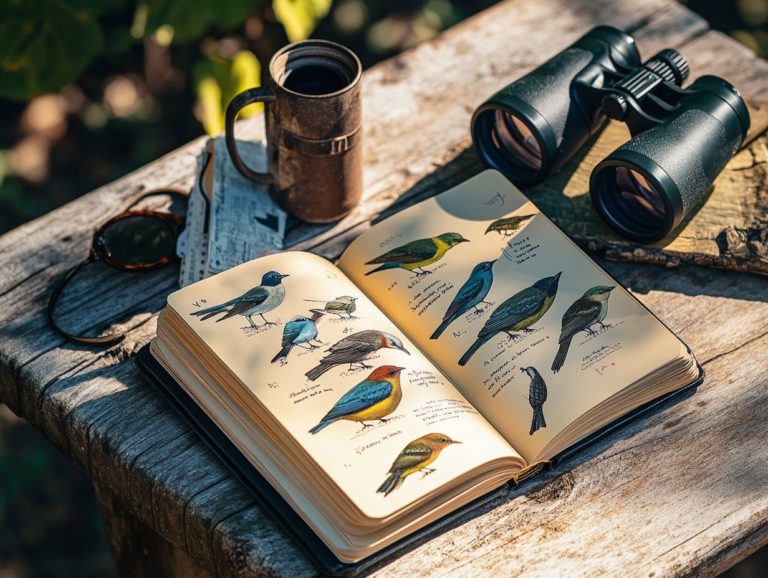Field Guides: Your Birdwatching Companion
Birdwatching can be a rewarding hobby. Identifying the many species often requires guidance.
Field guides are very helpful tools. They assist you in recognizing birds and understanding their behaviors better.
This article explores the benefits of field guides. It covers how to choose the right one and practical tips for effective birdwatching.
Contents
- Key Takeaways:
- What are Field Guides?
- Benefits of Using a Field Guide for Birdwatching
- Choosing the Right Field Guide
- How to Use a Field Guide
- Additional Tips for Birdwatching with a Field Guide
- Field Guide Apps and Online Resources for Birding Enthusiasts
- Frequently Asked Questions
- What is a field guide and why is it important for birdwatching?
- How do I choose the right field guide for my birdwatching needs?
- Can I use a digital or electronic field guide instead of a physical book?
- What should I look for in a good field guide for birdwatching, including digital options?
- Can a field guide help me learn more about a bird’s behavior and habitat?
- Are there different types of field guides available for birdwatching?
Key Takeaways:

- Field guides are essential for birdwatchers, helping with identification and information about bird behaviors.
- When selecting a guide, consider its size, illustrations, and how it’s organized.
- Follow a step-by-step approach to identify birds and use best practices to enhance your experience.
What are Field Guides?
Field guides are very helpful resources for anyone who loves birdwatching, as they provide vital insights into identifying various bird species across different habitats. Understanding the importance of field guides in bird watching can enhance your experience significantly.
For example, the *Midwest Birding Companion* by Stan Tekiela stands out. It serves both novice and experienced birders, showcasing the rich variety of birds in states like Illinois, Indiana, and Iowa.
These guides combine stunning images with detailed descriptions, showing how field guides can improve your birdwatching skills and helping you document your sightings in a birding journal.
Benefits of Using a Field Guide for Birdwatching
Using a field guide, like the *Midwest Birding Companion*, has many advantages for birdwatchers. It empowers you to accurately identify various species and deepen your understanding of bird behaviors.
These guides provide insights into preferred habitats and nesting patterns. They are great resources for both beginner birders and experienced wildlife photographers.
Identification Assistance
Field guides are your essential companions in the wild. They provide critical assistance for both novice and experienced birders, making them your companion in the outdoors.
With visual aids and detailed descriptions, you’ll find identifying birds straightforward and engaging.
These guides showcase vibrant illustrations that capture unique markings. They also provide tips for distinguishing closely related species, which can be a challenge.
For instance, the *National Geographic Field Guide to the Birds of North America* highlights subtle differences between birds like the Carolina and Black-capped Chickadees.
These guides enhance your observation skills and help deepen your appreciation of bird diversity in any outdoor setting.
Learning About Birds and Their Behaviors
Learning about birds and their behaviors is an enriching aspect of birding. It allows you to truly appreciate the intricacies of bird life and engage more deeply with nature.
By diving into field guides like the Midwest Birding Companion, you can uncover fascinating insights into the habits, songs, and nesting patterns of various bird species. This significantly enhances your overall birding experience and understanding of wildlife.
Field guides are invaluable resources. They provide detailed descriptions of captivating mating rituals, such as the elaborate courtship dances of the Greater Sage-Grouse and the striking displays of the Peacock.
Understanding feeding habits, including the specialized foraging techniques of Woodpeckers or the unique hunting strategies of Ospreys, empowers you to observe these remarkable species in action more effectively.
Insights into migration patterns help you anticipate seasonal visitors like the Ruby-throated Hummingbird. With each field guide, you immerse yourself in the rich tapestry of life found in your local ecosystems, deepening your connection to the natural world.
Choosing the Right Field Guide

Selecting the ideal field guide is essential for both novice and seasoned birders. Understanding how field guides change the birdwatching game can profoundly influence the quality of your birdwatching experience.
Resources such as the Midwest Birding Companion are meticulously crafted to accommodate the varied needs of birding enthusiasts. They offer valuable insights tailored to different skill levels and geographical contexts, including states like Illinois, Indiana, and Iowa.
Factors to Consider
When selecting a field guide, consider several key factors, such as regional specificity and the user-friendliness of the guide. This ensures it meets your individual needs, whether you re a beginner or an experienced birder.
A well-chosen guide, like the Midwest Birding Companion, will assist you in identifying birds and enhance your entire birdwatching experience, especially if you consider resources on understanding bird behavior with field guides.
Including vibrant illustrations and photographs can significantly enhance the visual appeal. This makes identification in the field much easier.
Descriptions of various habitats provide valuable context, helping you understand where to find different species based on their preferences. An accessible shipping and purchasing guide can also be a major advantage, especially if you want to quickly acquire essential resources without frustrating delays.
By taking these aspects into account, you can fully immerse yourself in the captivating world of watching birds, regardless of your experience level.
How to Use a Field Guide
Using a field guide effectively is crucial for birders like you. It helps you accurately identify birds and meticulously record their sightings in a birding journal.
This practice enriches your birdwatching experience and deepens your connection with nature.
Guides such as the Midwest Birding Companion provide comprehensive descriptions and stunning illustrations of various bird species. For those seeking even more resources, you can explore the most comprehensive bird field guides available, transforming the identification process into a straightforward and enjoyable journey, regardless of your skill level.
Step-by-Step Guide to Identification
A step-by-step guide to bird identification using a field guide offers you a structured approach. It empowers you to systematically identify and record the bird species you encounter in various habitats.
With resources like the Midwest Birding Companion at your fingertips, you can learn to focus on key identifiers, such as size, coloration, and behavior.
- Start with keen observation; take note of the bird’s physical characteristics, including its plumage patterns and bill shape these features are essential clues.
- Next, consider the habitat; whether you re in wetlands, forests, or grasslands, different species tend to gravitate toward specific environments.
- Once you’ve documented the key traits, refer to the field guide for confirmation. Cross-reference your observations with detailed illustrations and descriptions to ensure accuracy.
Engaging in this methodical process enhances your knowledge and deepens your appreciation for bird diversity. Each sighting becomes a rewarding learning experience that contributes to your personal birding journal.
Don t wait! Grab your field guide and head outside to discover the amazing world of birds!
Additional Tips for Birdwatching with a Field Guide
Incorporating additional tips can truly elevate your experience and effectiveness as a birder, especially when using guides like the Midwest Birding Companion. These tips help you make the most of your time in the field while sidestepping common pitfalls.
By following simple tips, you can sharpen your skills in identifying birds and documenting your sightings, whether you re utilizing the Midwest Birding Companion or any other birdwatching guides.
Best Practices and Common Mistakes to Avoid

Implementing best practices while birdwatching can immensely enhance your ability to identify birds and enjoy your time outdoors. By avoiding common pitfalls, you can save precious time and frustration during your outings.
Keeping a detailed birding journal and referring to a trusted birdwatching guide allows you to track your progress and learn more effectively from each experience.
Many birders tend to rush through identification, which often leads to misidentifications that can be quite disheartening. Take a moment to carefully observe key characteristics such as plumage colors, size, and vocalizations.
Don t overlook the habitat context where birds are found; distinguishing between species that typically inhabit wetlands versus those found in woodlands can significantly refine your possibilities.
To boost your identification success, using a field guide that includes habitat preferences is incredibly valuable. With patience, keen observation, and attention to environmental details, each outing can turn into an exciting adventure!
Field Guide Apps and Online Resources for Birding Enthusiasts
Along with traditional field guides, a wealth of field guide apps and online resources are now at your fingertips, making bird identification more convenient and interactive than ever.
These digital tools beautifully complement classic guides, such as the Midwest Birding Companion, by providing features like real-time updates on migrating birds and valuable user-generated data on bird sightings. For avid bird watchers, having regional bird field guides you need to own can enhance the overall experience.
Digital Options for Birdwatchers
Digital options, like birding apps and online resources, offer innovative ways to identify birds and learn about various bird species using the latest advancements in birdwatching technology. These solutions enhance interactivity and user engagement, making them invaluable companions to traditional field guides.
Many platforms boast comprehensive databases filled with stunning images and captivating sounds, immersing you in the vibrant world of birds. Community contributions invite you to share your observations, creating a rich tapestry of local birding knowledge that enhances everyone’s experience.
User-friendly interfaces make navigation a breeze, ensuring that both novice and seasoned birders can easily access a wealth of information. As technology evolves, these resources not only sharpen your identification skills but also deepen your appreciation for avian diversity and conservation efforts. You can document your birding journal and contribute to wildlife conservation.
Frequently Asked Questions
What is a field guide and why is it important for birdwatching?
Think of a field guide as your personal birding coach, packed with colorful pictures and details to help you identify birds! It is an essential tool for birdwatching, helping birders accurately identify the birds they see in the field.
How do I choose the right field guide for my birdwatching needs?

When choosing a field guide, consider the region where you will be birdwatching, the type of birds you are interested in, and the level of detail and identification features provided. Online reviews and recommendations from experienced birdwatchers can also help you make a decision.
Start your birdwatching journey today with these tools and tips!
Can I use a digital or electronic field guide instead of a physical book?
Yes, digital or electronic field guides can be convenient and environmentally friendly. Many offer features like bird sounds and interactive maps, but some birdwatchers still prefer physical books.
What should I look for in a good field guide for birdwatching, including digital options?
A good field guide should have clear pictures or photos of birds. It should also include details about their behavior and habitats.
Can a field guide help me learn more about a bird’s behavior and habitat?
Yes, a field guide can provide valuable information on a bird’s behavior and habitat. Understanding bird behavior helps in conservation by raising awareness of the need to protect their habitats.
For example, nesting boxes are artificial homes for birds, while bird feeders provide food. Both enhance the living environments for birds.
Are there different types of field guides available for birdwatching?
Yes, there are various types of field guides, including regional guides, family-specific guides, and comprehensive guides. Some field guides also focus on specific features such as bird songs or plumage.
It is important to choose a guide that suits your birdwatching needs and preferences.






